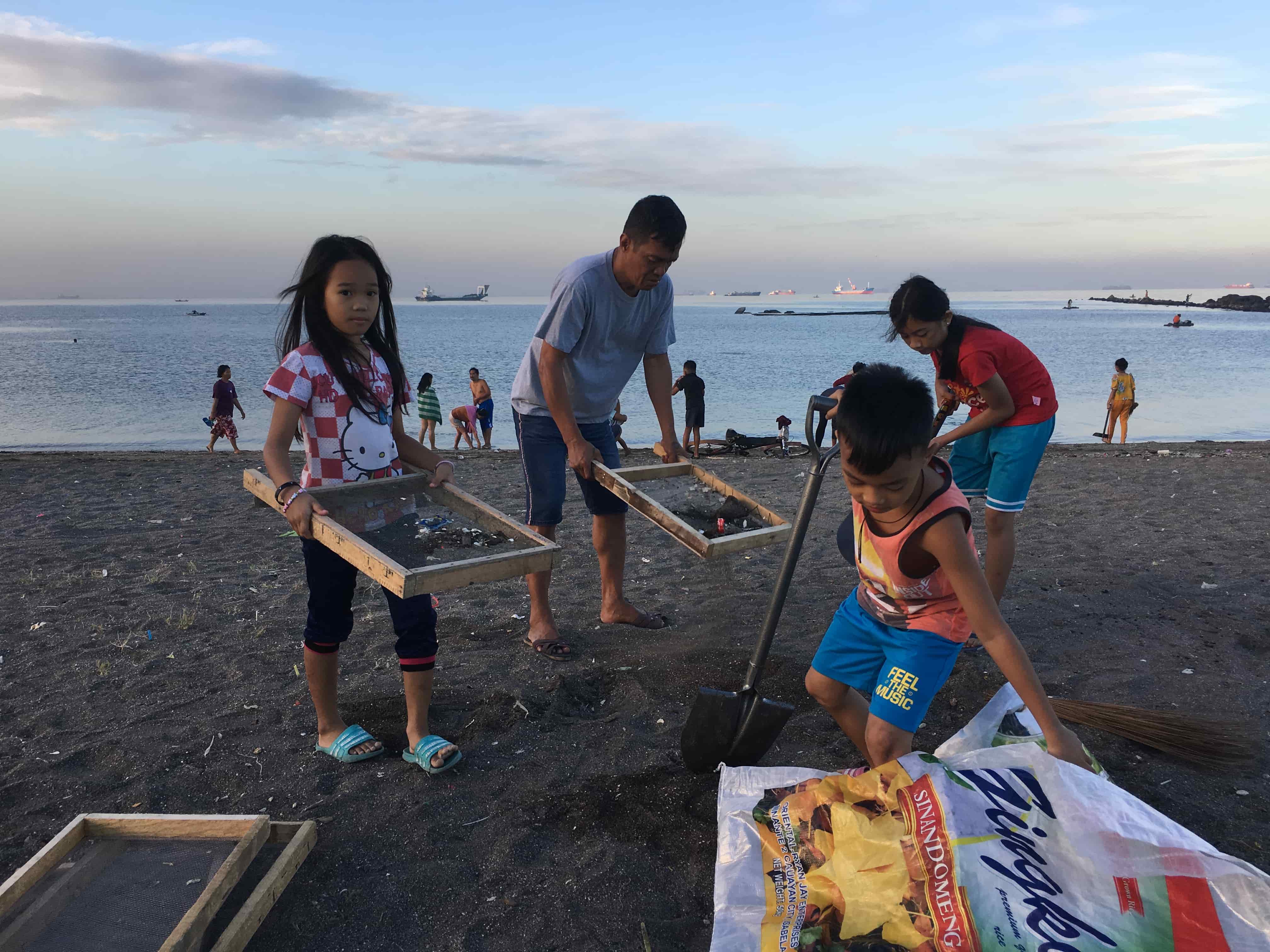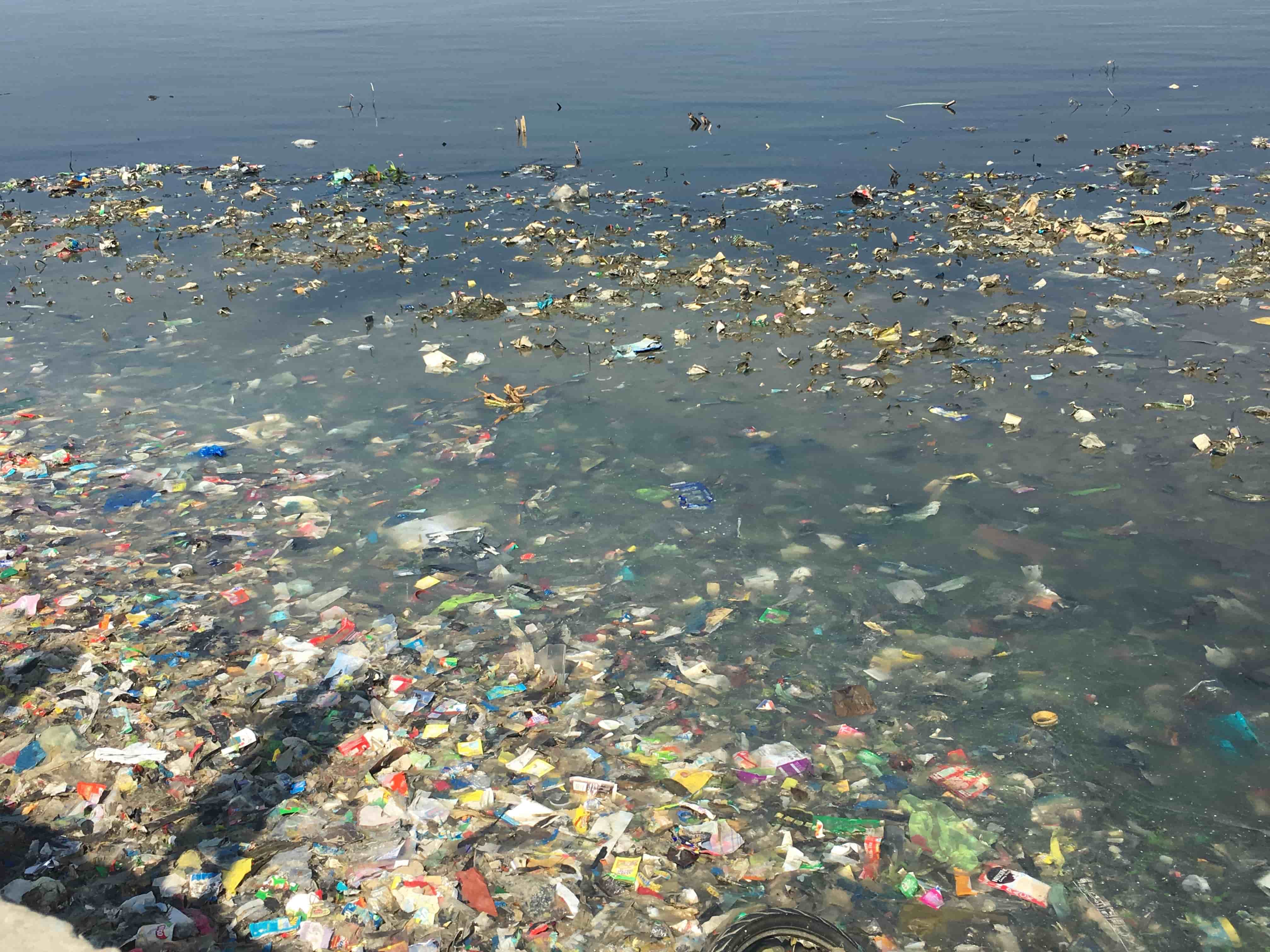It was a perfect day for somersaults at the beach.
Three teenagers took turns showing off their acrobatic skills, each impressively sticking their landings after taking running leaps into the waist-deep water.
The carefree Sunday we visited Baseco Beach, in Manila’s Tondo neighborhood, the teens were joined by hundreds of local residents, many of whom arrived at dawn to claim prime spots for their picnic mats and umbrellas.
Some basked under the March sun with their dogs as others waded in the water.
“Go and swim now, they’ll make you get out of there once the chairman gets here,” a woman shouted in Filipino at seemingly no one in particular.
Sure enough, an hour later, the beachgoers were directed to leave as village officials arrived to take charge of a growing group of volunteers who had been milling in the background, ready to clean up a beach that’s become a poster child for the Philippine’s plastic pollution problem.

In much of the world, seaside towns conjure images of affluent neighborhoods. But not in Manila, where places like Baseco host some of the city’s largest urban poor communities, where a poverty-driven reliance on single-use plastics is the norm.
A study released by the NGO Global Alliance for Incinerator Alternatives, or GAIA, in March found that nearly 60 billion tiny sachets and 17.5 billion plastic bags are used in the Philippines every year.
Many of these end up in coastal towns like Baseco, where mounds of discarded plastic have turned the water’s surface into a tragic rainbow color, and where the shore has become a nearly homogenous mix of garbage, sand, and soil.
Environmental organizations have long tried to combat the trash problem, and the government recently launched an ambitious rehabilitation project for Manila Bay, to which Baseco is joined by a tributary.
But with no clear, agreed-upon plan of attack, the beach’s future looks as murky as its waters.
Check out Coconuts TV’s accompanying video about Baseco Beach:
https://www.youtube.com/watch?v=L1LOrfKPXSE&t=19s
Beach cleanup
“My husband and I are here every morning to swim,” 44-year-old Leticia Combalicer told Coconuts Manila in Filipino as she sat on a mat on the Baseco Beach shore.
“Sometimes, when we don’t feel well, like when we have a cough, we take a dip in the water.”
The beach is a luxury for Baseco’s residents, though they’re well aware of its less-than-sterling reputation.
As some sunbathed, others were busy scooping up sand, straining it through make-shift sieves, and picking out the tiny pieces of plastic that remained.
The mat Combalicer was sitting on doubles as a sack for collecting garbage, something Baseco residents have begun doing every Sunday at 6am as part of an initiative by local government officials, who say it’s been effective.

“They now call Baseco ‘Baseco de Boracay,’ because people can see that it’s now clean, Baseco Village Councilor Edmundo Cayanan told Coconuts, referencing the Philippines’ popular beach destination.
Supporters of Philippine President Rodrigo Duterte have been quick to both celebrate this seeming improvement and credit the administration for it, though environmentalists say that there is still much left to be done.
“I think that’s a classic example of fake news,” GAIA Asia Pacific Coordinator Froilan Grate said of recent local media reports touting a cleaner Baseco.
“It might be cleaner as compared to before, but they’ve only picked up waste that’s visible to the eye from the seashore, right? But give it five, 10 days, and the sea will return the waste that’s being hidden under water.”
Baseco Beach lies at the mouth of the Pasig River, which connects it to Manila Bay. Because of this, garbage from all over Metro Manila and neighboring provinces ends up on its shores.
“[N]ot all the waste that you see from Baseco are created by the people who live in Baseco. A lot of it is really coming from upstream, but because of their geography, a lot of the waste ends up there,” Grate said.
The only way to truly mitigate the beach’s garbage problem, he insists, is to first cure the ills of nearby Manila Bay.

Battle for Manila Bay
Grate calls Manila Bay the city’s biggest dumpsite.
“Just go along the coast of Manila Bay and it feels like a big shopping mall, because you have all the brands, all the packaging,” he said.
The Bay covers eight provinces and ends up as a depository for trash from as far as Tarlac, a province 130 kilometers north of Manila. But while pieces of plastic still float in its waters, they’re less visible now amid a highly publicized government rehabilitation project that has seen barricades set up along the popular Baywalk along Roxas Boulevard.
Dramatically called the “Battle for Manila Bay,” it was launched in January with a budget of PHP47 billion (approx. US$895 million). A major part of the Department of Environment and National Resources’ (DENR) plan is to implement a solid waste management plan that all communities can follow.
DENR Undersecretary Jonas Leones told Coconuts in a recent interview that only about 30 to 40 percent of local government units (LGUs) nationwide are fully complying with the Solid Waste Management Act.
Enacted in 2000, the law requires garbage segregation at the source, the conversion of open dumps to controlled dumps (i.e. ones that meet at least minimum standards), and the establishment of recycling, composting, and materials recovery facilities.
These responsibilities lie in the hands of the local governments, but they require funding, which is why poorer communities routinely fail to follow the law to the letter.
“Maybe in urban areas like Metro Manila, the local government units have resources. They also have the MMDA (Metropolitan Manila Development Authority) there. But outside Metro Manila, it’s the local government that is responsible for [implementing solid waste management],” Leones said.
Because there are no proper facilities and waste collection systems, much of the garbage littering the streets makes its way into the myriad waterways that flow into Manila Bay.
Leones said that the Environment Department plans to provide technical and financial assistance to help these communities, but Grate, the environmentalist, said that even areas with proper facilities are often overwhelmed by the sheer amount of waste being produced.
“The reality is that even in places where there are infrastructure or collection programs, some of that waste is really problematic,” he said. “Despite the best efforts of the communities, they cannot compost this waste, they cannot recycle this waste.”
In 2017, the MMDA said that Metro Manila’s three landfills would likely be unusable by 2037 due to the amount of trash being generated.
For Grate and other environmentalists, the problem isn’t just the lack of waste management, but that plastic is being produced at all.

A plan built on sand
Cayanan, the Baseco village councilor, has been living in the neighborhood for 35 years. He woke up late that Sunday, but still managed to make it to the beach in time to oversee the last minutes of the cleanup. His voice oozed with pride as he talked about his beloved local initiatives.
“When you say let’s help each other, let’s come together to clean Baseco, residents heed the call,” he said.
From where he was standing, the beach indeed looked cleaner than it had before. But floating in the same body of water just a few meters away were empty shampoo sachets, ketchup packets, and even an old computer keyboard.
Cayanan said they’ve cleaned up that part before but more trash just came flowing back. He seemed resigned to the idea that cleaning the beach could be a lifetime commitment.
“This is just what’s going to happen whenever we clean. Because if we really can’t stop people from throwing their trash in the river or sea, we should just clean,” he said.
But Grate doesn’t see that as a sustainable solution.
“As long as we don’t stop the source of the problem, we’ll have to clean up forever,” he said.
The source, he believes, is corporations’ continued use of plastic to package their products.
“Plastic pollution happens right at the very moment that plastic is made,” Grate said.

In the Philippines, everything from shampoo to soy sauce is sold in tiny plastic packaging. They’re especially popular in lower-income communities like Baseco, where people barely have enough money for a day’s basic needs.
For example, corner stores routinely repack and sell sugar in single-serving sizes so people won’t have to shell out too much money in one go.
It’s no surprise then that a United Nations Environment Program status report from June last year revealed that the Philippines is one of only five countries responsible for about half the total plastic waste that ends up in the world’s oceans.
Studies like this and viral photos of sea animals that have died because of plastic are fueling a burgeoning zero-waste community in the Philippines. In March, Unilever — once named a top plastic polluter — launched refilling stations where customers can buy their shampoos and conditioners sans the packaging.
Even regular citizens have started to say no to plastic, a movement Cayanan, the village councilor, agrees is necessary.
“If possible, let’s stop the manufacturing of the plastic we use so that people no longer throw it in the water after [using it]. Maybe we can just use paper,” he offered.
Not a bad idea, though given that there has been precisely zero movement at the national level to require corporations to stop using plastic, residents of coastal towns like Baseco can expect to continue cleaning up the mess for the foreseeable future.
“People or communities like Baseco are more [victims] of the problem,” Grate said. “Yes, they do contribute to it, but they suffer more than they contribute.”



Reader Interactions